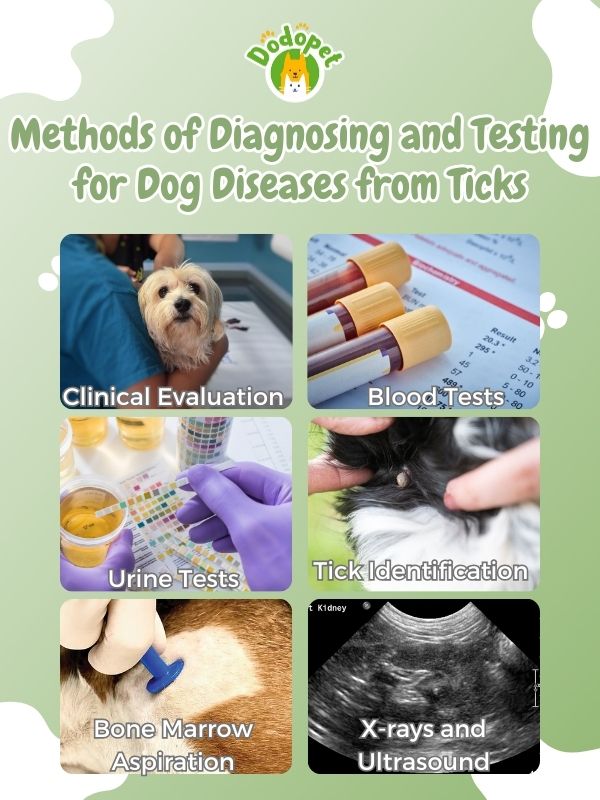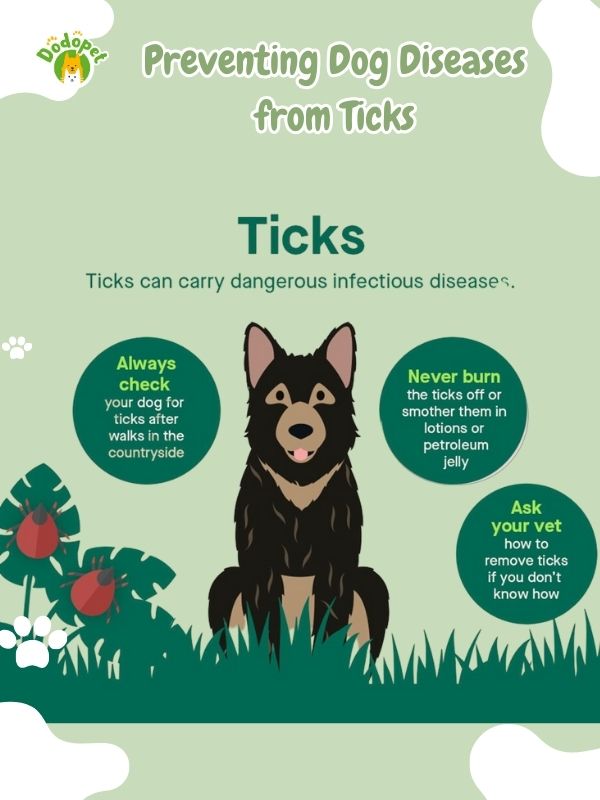Ticks, those tiny but formidable creatures, can pose a significant threat to our beloved canine companions. They’re not just bloodsucking pests; they’re the culprits behind several debilitating diseases in dogs. In this comprehensive guide, we will unveil the hidden dangers of dog diseases from ticks, shedding light on Lyme disease, Ehrlichiosis, Anaplasmosis, Babesiosis, and Rocky Mountain spotted fever. Let’s unmask the invisible and empower you with the knowledge to protect your furry friend’sReadability health and well-being.
The Dangers of Dog Diseases from Ticks
Tick-borne diseases (dog diseases from ticks) pose a significant threat to the health and well-being of dogs. These tiny parasites can transmit a variety of harmful pathogens that can cause serious illnesses in our furry friends. It is crucial for dog owners to be aware of these invisible threats and take proactive measures to protect their pets.
Understanding Lyme Disease in Dogs
Lyme disease is one of the most common tick-borne illnesses in dogs. It is caused by the bacterium Borrelia burgdorferi, which is transmitted through the bite of infected black-legged ticks. Dogs infected with Lyme disease may experience symptoms such as lameness, fever, lethargy, and loss of appetite. If left untreated, Lyme disease can lead to more severe complications, including kidney damage and neurological disorders.
Spotting Ehrlichiosis: A Silent Killer
Ehrlichiosis is another dangerous tick-borne disease that can affect dogs. It is caused by the bacteria Ehrlichia canis, which is transmitted through the bite of infected brown dog ticks. This disease can be challenging to diagnose as its symptoms are often nonspecific and can mimic other illnesses. Common signs of ehrlichiosis in dogs include fever, loss of appetite, weight loss, and bleeding disorders. Without prompt treatment, ehrlichiosis can be fatal.
Babesiosis: A Blood Parasite Infection
Babesiosis is a tick-borne disease caused by the protozoan parasite Babesia. It is transmitted through the bite of infected ticks, such as the brown dog tick or the American dog tick. Babesiosis can cause severe anemia in dogs, leading to symptoms such as pale gums, weakness, and fatigue. In some cases, it can also result in organ failure and even death. Early detection and treatment are crucial for a successful recovery.
Anaplasmosis: A Tick-Borne Bacterial Infection
Anaplasmosis is a bacterial infection caused by the bacteria Anaplasma phagocytophilum or Anaplasma platys. It is transmitted through the bite of infected ticks, including the black-legged tick and the western black-legged tick. Dogs with anaplasmosis may exhibit symptoms such as fever, joint pain, lethargy, and loss of appetite. If left untreated, anaplasmosis can lead to more severe complications, including organ damage and immune system dysfunction.
Rocky Mountain Spotted Fever: A Deadly Disease
The bacteria Rickettsia rickettsii causes Rocky Mountain spotted fever (RMSF), a potentially lethal tick-borne disease. It is typically spread by infected American dog ticks, Rocky Mountain wood ticks, and brown dog ticks. Infected dogs may exhibit signs such as loss of appetite, fever, a skin rash and lethargy. RMSF can cause organ failure and death if not treated promptly.

The Dcangers of Dog Diseases from Ticks
Recognizing Symptoms of Dog Diseases from Ticks
Tick-borne diseases in dogs are caused by various types of parasites, such as ticks, that transmit infectious agents when they bite. Consequently, dog diseases from ticks can vary in severity and may have a wide range of symptoms. Common tick-borne diseases in dogs include Lyme disease, Ehrlichiosis, Anaplasmosis, Babesiosis, and Rocky Mountain spotted fever. Therefore, here are some general symptoms to watch for if you suspect your dog may have a tick-borne disease.:
- Fever: A persistent fever is a common symptom of many tick-borne diseases. Normal canine body temperature ranges from 99.5°F to 102.5°F (37.5°C to 39.2°C), so any temperature above this range should be considered a fever.
- Lethargy: dog diseases from ticks may appear unusually tired or lethargic. They might have a lack of energy and be less interested in their usual activities.
- Joint Pain: Some tick-borne diseases, like Lyme disease, can cause joint pain and lameness in dogs. You may notice your dog limping or favoring certain legs.
- Loss of Appetite: Dogs with tick-borne illnesses may experience a decrease in appetite or refuse to eat altogether. This can lead to weight loss if left untreated.

Recognizing Symptoms of Dog Diseases from Ticks
- Swelling and Pain: Swollen lymph nodes, joints, or limbs may be a symptom of certain tick-borne diseases. The affected areas can be painful and tender to the touch.
- Vomiting and Diarrhea: Gastrointestinal symptoms like vomiting and diarrhea can occur in some cases. This can lead to dehydration if not addressed.
- Difficulty Breathing: Tick-borne diseases like Babesiosis can affect a dog’s red blood cells, leading to anemia and potentially causing difficulty breathing.

Recognizing Symptoms of Dog Diseases from Ticks (2)
Methods of Diagnosing and Testing for Dog Diseases from Ticks
Diagnosing and testing for tick-borne diseases in dogs typically involves a combination of clinical evaluation, blood tests, and sometimes other diagnostic methods. Here are some common methods used to diagnose tick-borne diseases in dogs:
Clinical Evaluation for Dog Diseases from Ticks
The veterinarian will begin by conducting a thorough physical examination of your dog. They will ask you about your dog’s medical history and any recent exposure to ticks or tick-prone areas. Clinical signs and symptoms, such as fever, joint pain, or lethargy, can provide important initial clues.
Blood Tests for Dog Diseases from Ticks
- Serology: Serological tests, such as the enzyme-linked immunosorbent assay (ELISA) or indirect fluorescent antibody (IFA) test, are commonly used to detect antibodies produced by the dog’s immune system in response to the tick-borne pathogen. Elevated antibody levels can indicate exposure or infection.
- Polymerase Chain Reaction (PCR): PCR tests can detect the DNA of the tick-borne pathogens directly in a blood sample. This method is often more specific than serology and can confirm the presence of the pathogen.
- Complete Blood Count (CBC): A CBC can reveal abnormalities such as anemia, which may be associated with certain tick-borne diseases like Babesiosis.
- Blood Chemistry Panel: This panel assesses the function of organs like the liver and kidneys, which can be affected by some tick-borne diseases. It can also help monitor overall health.
Urine Tests
Some dog diseases from ticks, like Leptospirosis, can be diagnosed through urine tests. Urinalysis can reveal the presence of abnormal proteins or blood in the urine.
Tick Identification
If you find ticks on your dog, you can have them identified to determine if they are carriers of tick-borne pathogens. This information can be valuable in assessing the risk of infection.
Bone Marrow Aspiration for Dog Diseases from Ticks
In severe cases of certain tick-borne diseases, a bone marrow aspiration may be necessary to assess the extent of damage to the bone marrow and identify the pathogen.
X-rays and Ultrasound
In cases where there is suspicion of organ involvement, such as the spleen or liver, imaging techniques like X-rays or ultrasound may be used to evaluate the extent of damage or enlargement.

Methods of Diagnosing and Testing for Dog Diseases from Ticks
Treatment Options for Dogs Infected by Dog Diseases from Ticks
The treatment of dog diseases from ticks depends on the specific disease involved, its severity, and the overall health of the dog. Treatment typically involves medications to target the causative pathogen, manage symptoms, and provide supportive care. Below are common tick-borne diseases in dogs and their treatment options:
- Lyme Disease:
- Antibiotics: Doxycycline or amoxicillin are commonly prescribed antibiotics to treat Lyme disease in dogs.
- Pain relief: Non-steroidal anti-inflammatory drugs (NSAIDs) may be used to manage joint pain.
- Supportive care: Rest, good nutrition, and hydration are essential during recovery.
- Ehrlichiosis:
- Doxycycline: This antibiotic is effective against Ehrlichia bacteria.
- Supportive care: Dogs with severe Ehrlichiosis may require hospitalization for intravenous fluids and other supportive measures.
- Anaplasmosis:
- Doxycycline or other appropriate antibiotics may be prescribed.
- Pain management: NSAIDs can help alleviate joint pain and fever.
- Babesiosis:
- Treatment for Babesiosis may involve a combination of medications such as atovaquone and azithromycin or clindamycin and quinine.
- Blood transfusion: In severe cases of anemia, a blood transfusion may be necessary.
- Supportive care: Ensuring hydration and monitoring for complications like kidney failure is important.
- Rocky Mountain Spotted Fever:
- Doxycycline is the primary treatment for Rocky Mountain spotted fever in dogs.
- Supportive care: Addressing dehydration, fever, and other symptoms is crucial.
- Tick Paralysis:
- Removal of ticks: The first step is to remove any attached ticks carefully.
- Supportive care: Ensuring the dog gets adequate oxygen and supportive treatments like intravenous fluids and medications to relieve muscle weakness.
- Leishmaniasis:
- Treatment may involve medications like antimonials, allopurinol, or miltefosine, depending on the severity and form of the disease.
- Supportive care: Monitoring for complications and addressing organ dysfunction is essential.

The Dcangers of Dog Diseases from Ticks
Preventing Dog Diseases from Ticks
Prevention is key when it comes to protecting dogs from tick-borne diseases. By implementing the following measures, dog owners can significantly reduce the risk of their pets contracting these devastating illnesses:
- Use tick preventatives recommended by veterinarians
- Regularly check dogs for ticks, especially after outdoor activities
- Keep the yard and surrounding areas well-maintained to minimize tick habitats
- Avoid walking dogs in tall grass or wooded areas where ticks are commonly found
Consider vaccination options available for specific tick-borne disease.

Preventing Dog Diseases from Ticks
Conclusion
Tick-borne diseases pose a significant threat to the health and well-being of dogs. Furthermore, Lyme disease, ehrlichiosis, babesiosis, anaplasmosis, and Rocky Mountain spotted fever are just a few examples of the devastating illnesses that can be transmitted by ticks. Therefore, by understanding the risks and taking proactive measures to prevent tick bites, dog owners can help protect their furry friends from these invisible dangers. Additionally, early detection and prompt treatment are crucial for the successful management of tick-borne diseases. Consequently, if a dog shows any signs of illness or has been exposed to ticks, it is essential to seek veterinary care immediately. In conclusion, together, we can unmask the invisible and keep our beloved dogs safe and healthy.









